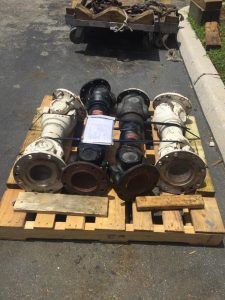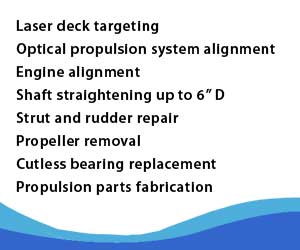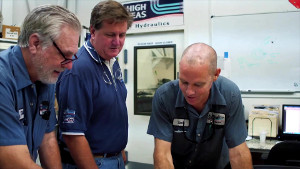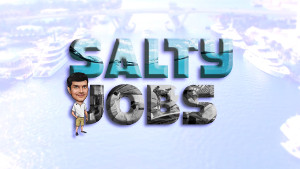Strut Alignment using Cardan Shafts
 As discussed in a previous post, we were commissioned to perform a strut alignment on a 120’ Ferretti after she ran aground. This vessel had cardan shafts. Marine cardan shafts, while fundamentally the same as u-joint shafts in cars and trucks, are unique because of the large flanges they have for higher horse power capabilities. They are commonly used with remote transmissions where the transmission (gearbox) are separate from the main engine.
As discussed in a previous post, we were commissioned to perform a strut alignment on a 120’ Ferretti after she ran aground. This vessel had cardan shafts. Marine cardan shafts, while fundamentally the same as u-joint shafts in cars and trucks, are unique because of the large flanges they have for higher horse power capabilities. They are commonly used with remote transmissions where the transmission (gearbox) are separate from the main engine.
Once we removed the cardan shafts from the boat, we sent them to a company in the Mid-West where they inspected and replaced where needed the needle bearings in the universal joints (U-joint) and balanced the shafts. Balancing cardan shafts takes a highly-specialized piece of equipment.
It is very important to balance the cardan shaft to eliminate the possibility of torsional vibrations. Torsional vibrations are caused by two things: the u-joint operating angle at the “drive” end of the drive shaft and the orientation (phasing) of the yokes at each end of the drive shaft. A torsional vibration is a twice per revolution vibration. It will cause the drive shaft, “downstream” of the front U-joint, to “speed up” and “slow down” twice per revolution. That means that the engine producing a constant speed of 3,000 RPM can actually be attached to the drive shaft that is changing speed 6,000 times per minute. The amount of that change in speed, called the magnitude, or size of the change, is proportional to the size of the angle at the drive end of the drive shaft, or the amount of misalignment between the yokes at the drive and driven end of your drive shaft. Torsional vibrations are serious vibrations that can cause the shaft to bend and potentially break.
When a drive shaft is assembled, its inner components usually consist of a slip yoke on one end and a tube yoke on the other end, and they are usually assembled in relation to each other. This is called PHASING. Most drive shafts are assembled with their yokes in line, or “IN PHASE”. A drive shaft that is “in phase” and has the correct operating angles at the drive end of the shaft does not create a torsional vibration. Drive shafts that are NOT in phase will vibrate with the same twice per revolution vibration as a drive shaft with incorrect operating angles.
Understanding the intricacies of the various components found in many mega-yachts ensures that the job gets done and gets done right.


 Click to watch the video of a day at High Seas Yacht Service.
Click to watch the video of a day at High Seas Yacht Service. Click to watch Marine Industries Association of South Florida video featuring Salty Jobs at High Seas Services.
Click to watch Marine Industries Association of South Florida video featuring Salty Jobs at High Seas Services.
Comments are closed.